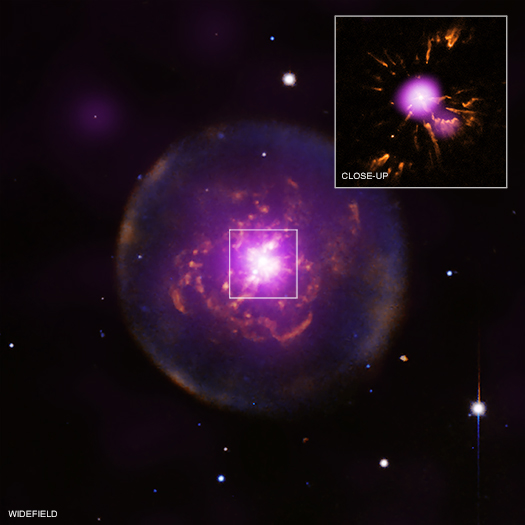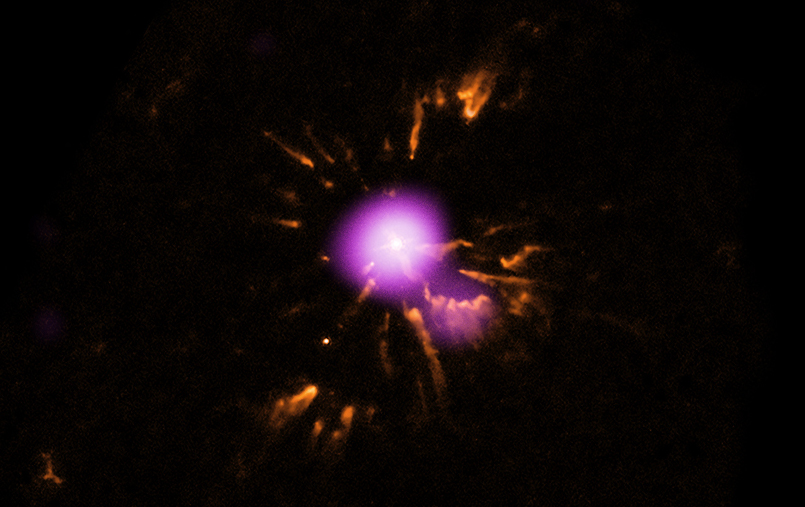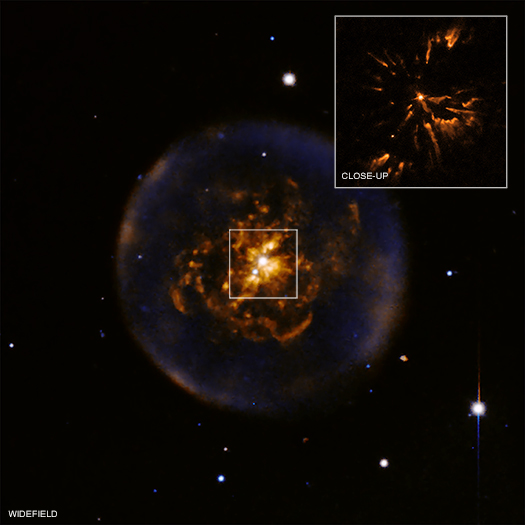

| Visitors Now: | |
| Total Visits: | |
| Total Stories: |

| Story Views | |
| Now: | |
| Last Hour: | |
| Last 24 Hours: | |
| Total: | |
Cosmic Rebirth: Planetary Nebula Reborn
This new picture of the planetary nebula Abell 30, located 5500 light-years from Earth, is a composite of visible images from the NASA/ESA Hubble Space Telescope and X-ray data from ESA’s XMM-Newton and NASA’s Chandra space telescopes.
‘Planetary nebula’ is the name given to the often-concentric shells of stellar material cast into space by dying stars. To astronomers of the 18th century, these objects looked like the colourful ‘blob’ of a planet through their telescopes, and the name stuck.

Inset X-ray (NASA/CXC/IAA-CSIC/M.Guerrero et al); Inset Optical (NASA/STScI); Widefield X-ray (ESA/XMM-Newton); Widefield Optical (NSF/NOAO/KPNO)
The large image and the inset show X-ray and optical data from Chandra, XMM-Newton, HST and KPNO.
A planetary nebula is formed in the late stage of the evolution of a sun-like star.
The evolution of A30 stalled and then started up again, so the planetary nebula was reborn, a special, rarely-seen phase of evolution.
These images of the planetary nebula Abell 30, (a.k.a. A30), show one of the clearest views ever obtained of a special phase of evolution for these objects. The inset image on the right is a close-up view of A30 showing X-ray data from NASA’s Chandra X-ray Observatory in purple and Hubble Space Telescope (HST) data showing optical emission from oxygen ions in orange. On the left is a larger view showing optical and X-ray data from the Kitt Peak National Observatory and ESA’s XMM-Newton, respectively. In this image the optical data show emission from oxygen (orange) and hydrogen (green and blue), and X-ray emission is colored purple.
A planetary nebula – so called because it looks like a planet when viewed with a small telescope – is formed in the late stage of the evolution of a sun-like star.
After having steadily produced energy for several billion years through the nuclear fusion of hydrogen into helium in its central region, or core, the star undergoes a series of energy crises related to the depletion of hydrogen and subsequent contraction of the core. These crises culminate in the star expanding a hundred-fold to become a red giant.
Eventually the outer envelope of the red giant is ejected and moves away from the star at a relatively sedate speed of less than 100,000 miles per hour. The star meanwhile is transformed from a cool giant into a hot, compact star that produces intense ultraviolet (UV) radiation and a fast wind of particles moving at about 6 million miles per hour. The interaction of the UV radiation and the fast wind with the ejected red giant envelope creates the planetary nebula, shown by the large spherical shell in the bigger image.
In rare cases, nuclear fusion reactions in the region surrounding the star’s core heat the outer envelope of the star so much that it temporarily becomes a red giant again. The sequence of events – envelope ejection followed by a fast stellar wind – is repeated on a much faster scale than before, and a small-scale planetary nebula is created inside the original one. In a sense, the planetary nebula is reborn.

Chandra X-ray & Hubble Optical Close-up of A30
The large nebula seen in the larger image has an observed age of about 12,500 years and was formed by the initial interaction of the fast and slow winds. The cloverleaf pattern of knots seen in both images, correspond to the recently ejected material. These knots were produced much more recently, as they have an observed age of about 850 years, based on observations of their expansion using HST.
The diffuse X-ray emission seen in the larger image and in the region around the central source in the inset is caused by interactions between wind from the star and the knots of the ejected material. The knots are heated and eroded by this interaction, producing X-ray emission. The cause of the point-like X-ray emission from the central star is unknown.
Studies of A30 and other planetary nebulas help improve our understanding of the evolution of sun-like stars as they near the end of their lifetime. The X-ray emission reveals how the material lost by the stars at different evolutionary stages interact with each another. These observations of A30, located about 5,500 light years away, provide a picture of the harsh environment that the solar system will evolve towards in several billion years, when the sun’s strong stellar wind and energetic radiation will blast those planets that survived the previous, red giant phase of stellar evolution.
The structures seen in A30 originally inspired the idea of reborn planetary nebulas, and only three other examples of this phenomenon are known. A new study of A30, using the observatories mentioned above, has been reported by an international team of astronomers in the August 20th, 2012 issue of The Astrophysical Journal.

The first author of the paper reporting these results is Martín A. Guerrero of the Instituto de Astrofísica de Andalucía (IAA-CSIC) in Spain. The other authors are N. Ruiz, also from the IAA-CSIC, Spain; W.-R. Hamann, from the University of Potsdam, Germany; Y.-H. Chu, from the University of Illinois, Urbana, IL; H. Todt, from the University of Potsdam, Germany; D. Schönberner, from the Leibniz-Institut Für Astrophysik in Potsdam, Germany; L. Oskinova, from the University of Potsdam, Germany; R. Gruendl, from the University of Illinois, Urbana, IL; M. Steffen, from the Leibniz-Institut Für Astrophysik in Potsdam, Germany; W. Blair, from Johns Hopkins University in Baltimore, MD and J. Toalá from the IAA-CSIC, Spain.

Astronomers now know that as a star with less than eight times the mass of the Sun swells into a red giant towards the end of its life, its outer layers are expelled via pulsations and winds.
Ultraviolet radiation shining out from the stripped-down hot stellar core then lights up the ejected shells, resulting in intricate artworks that can be seen by modern telescopes.
The star at the heart of Abell 30 experienced its first brush with death
12 500 years ago – as seen from Earth – when its outer shell was stripped off by a slow and dense stellar wind.
Optical telescopes see the remnant of this evolutionary stage as a large, near-spherical shell of glowing material expanding out into space.
Then, about 850 years ago, the star suddenly came back to life, coughing out knots of helium and carbon-rich material in a violent event.
The star’s outer envelope briefly expanded during this born-again episode, but then very rapidly contracted again witin 20 years.
This had the knock-on effect of accelerating the wind from the star to its present speed of 4000 kilometres per second – over 14 million kilometres per hour.
As this fast stellar wind catches up and interacts with the slower wind and clumps of previously ejected material, complex structures are formed, including the delicate comet-like tails seen near the central star in this image.
The stellar wind bombarding dense clumps of material provides a chilling look at the possible fate of Earth and its fellow planets in our own Solar System in a few billion years’ time.
When our Sun emits its final gasps of life at the heart of a planetary nebula, its strong stellar wind and harsh radiation will blast and evaporate any planets that may have survived the red giant phase of stellar evolution.
If any distant civilisation is watching with high-power telescopes at the time, they might see the glowing embers of the planets light up in X-rays as they are engulfed in the stellar wind.
NASA’s Marshall Space Flight Center in Huntsville, Ala., manages the Chandra program for NASA’s Science Mission Directorate in Washington. The Smithsonian Astrophysical Observatory controls Chandra’s science and flight operations from Cambridge, Mass.


